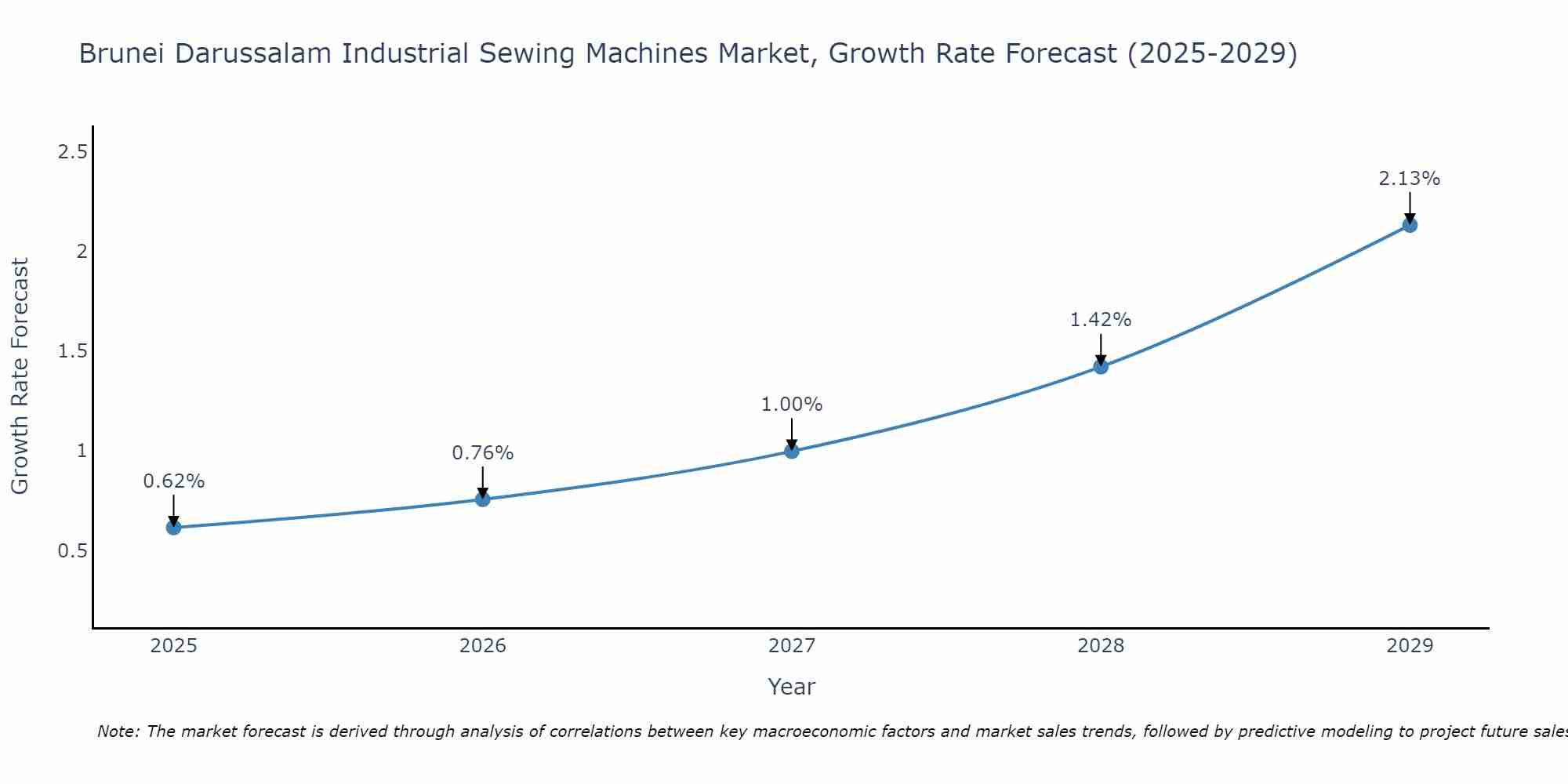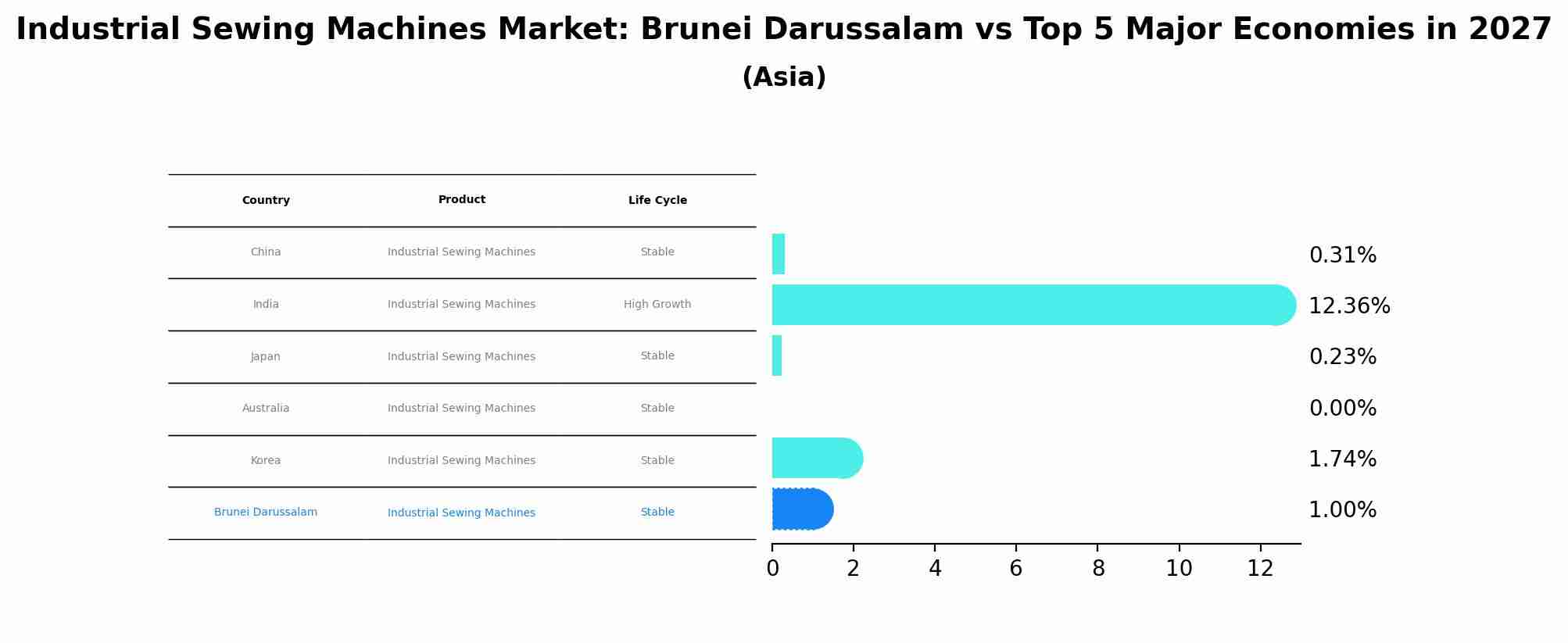Brunei Industrial Sewing Machines Market (2025-2031) | Revenue, Forecast, Trends, Segmentation, Outlook, Industry, Size, Growth, Companies, Value, Share & Analysis
| Product Code: ETC4742790 | Publication Date: Nov 2023 | Updated Date: Apr 2025 | Product Type: Market Research Report | |
| Publisher: 6Wresearch | Author: Shubham Deep | No. of Pages: 60 | No. of Figures: 30 | No. of Tables: 5 |
Brunei Darussalam Industrial Sewing Machines Market Size Growth Rate
The Brunei Darussalam Industrial Sewing Machines Market is likely to experience consistent growth rate gains over the period 2025 to 2029. Commencing at 0.62% in 2025, growth builds up to 2.13% by 2029.

Industrial Sewing Machines Market: Brunei Darussalam vs Top 5 Major Economies in 2027 (Asia)
By 2027, the Industrial Sewing Machines market in Brunei Darussalam is anticipated to reach a growth rate of 1.00%, as part of an increasingly competitive Asia region, where China remains at the forefront, supported by India, Japan, Australia and South Korea, driving innovations and market adoption across sectors.

Brunei Industrial Sewing Machines Market Overview
The industrial sewing machines market in Brunei is expanding as sewing machines are essential for textile and garment manufacturing processes. Industrial sewing machines are used in applications such as stitching, sewing, and embroidery in sectors such as fashion, automotive, and furniture. The market growth is driven by advancements in sewing machine technologies, the increasing demand for high-performance and durable machines, and the expansion of textile and garment industries. The focus on improving sewing machine performance and meeting industry standards is contributing to the growth of the industrial sewing machines market.
Drivers of the market
The industrial sewing machines market in Brunei is growing due to the increasing demand for efficient and high-performance sewing solutions in the textile and garment industries. Industrial sewing machines are used for mass production of clothing, fabrics, and textiles. The market is driven by advancements in sewing machine technologies, rising industrial activities, and the growing need for precision and efficiency in textile production.
Challenges of the market
The Industrial Sewing Machines Market in Brunei is constrained by the relatively small size of the local manufacturing and textile sectors. High production and import costs, coupled with limited local manufacturing capabilities, hinder market growth. Additionally, competition from alternative sewing technologies and fluctuating demand from various industries impact market stability. The market also faces challenges related to technological advancements and the need for innovative sewing solutions.
Government Policy of the market
Bruneis government policies in the industrial sewing machines market focus on safety, efficiency, and technological innovation. Regulations ensure that industrial sewing machines meet high standards for performance and safety in textile manufacturing. The government supports the development and adoption of advanced sewing machine technologies that enhance productivity and quality. Additionally, there is a focus on promoting regular maintenance and adherence to safety standards. By enforcing rigorous regulations and encouraging innovation, the government aims to support a high-performance and efficient industrial sewing machines market.
Key Highlights of the Report:
- Brunei Industrial Sewing Machines Market Outlook
- Market Size of Brunei Industrial Sewing Machines Market, 2024
- Forecast of Brunei Industrial Sewing Machines Market, 2031
- Historical Data and Forecast of Brunei Industrial Sewing Machines Revenues & Volume for the Period 2021-2031
- Brunei Industrial Sewing Machines Market Trend Evolution
- Brunei Industrial Sewing Machines Market Drivers and Challenges
- Brunei Industrial Sewing Machines Price Trends
- Brunei Industrial Sewing Machines Porter`s Five Forces
- Brunei Industrial Sewing Machines Industry Life Cycle
- Historical Data and Forecast of Brunei Industrial Sewing Machines Market Revenues & Volume By Fabric Weight for the Period 2021-2031
- Historical Data and Forecast of Brunei Industrial Sewing Machines Market Revenues & Volume By Lightweight for the Period 2021-2031
- Historical Data and Forecast of Brunei Industrial Sewing Machines Market Revenues & Volume By Medium Weight for the Period 2021-2031
- Historical Data and Forecast of Brunei Industrial Sewing Machines Market Revenues & Volume By Heavy Weight for the Period 2021-2031
- Historical Data and Forecast of Brunei Industrial Sewing Machines Market Revenues & Volume By Extra-heavy Weight for the Period 2021-2031
- Historical Data and Forecast of Brunei Industrial Sewing Machines Market Revenues & Volume By Bed Type for the Period 2021-2031
- Historical Data and Forecast of Brunei Industrial Sewing Machines Market Revenues & Volume By Flat Bed for the Period 2021-2031
- Historical Data and Forecast of Brunei Industrial Sewing Machines Market Revenues & Volume By Cylinder Bed for the Period 2021-2031
- Historical Data and Forecast of Brunei Industrial Sewing Machines Market Revenues & Volume By Post Bed for the Period 2021-2031
- Historical Data and Forecast of Brunei Industrial Sewing Machines Market Revenues & Volume By Application for the Period 2021-2031
- Historical Data and Forecast of Brunei Industrial Sewing Machines Market Revenues & Volume By Apparel for the Period 2021-2031
- Historical Data and Forecast of Brunei Industrial Sewing Machines Market Revenues & Volume By Non-apparel for the Period 2021-2031
- Brunei Industrial Sewing Machines Import Export Trade Statistics
- Market Opportunity Assessment By Fabric Weight
- Market Opportunity Assessment By Bed Type
- Market Opportunity Assessment By Application
- Brunei Industrial Sewing Machines Top Companies Market Share
- Brunei Industrial Sewing Machines Competitive Benchmarking By Technical and Operational Parameters
- Brunei Industrial Sewing Machines Company Profiles
- Brunei Industrial Sewing Machines Key Strategic Recommendations
Frequently Asked Questions About the Market Study (FAQs):
1 Executive Summary |
2 Introduction |
2.1 Key Highlights of the Report |
2.2 Report Description |
2.3 Market Scope & Segmentation |
2.4 Research Methodology |
2.5 Assumptions |
3 Brunei Industrial Sewing Machines Market Overview |
3.1 Brunei Country Macro Economic Indicators |
3.2 Brunei Industrial Sewing Machines Market Revenues & Volume, 2021 & 2031F |
3.3 Brunei Industrial Sewing Machines Market - Industry Life Cycle |
3.4 Brunei Industrial Sewing Machines Market - Porter's Five Forces |
3.5 Brunei Industrial Sewing Machines Market Revenues & Volume Share, By Fabric Weight, 2021 & 2031F |
3.6 Brunei Industrial Sewing Machines Market Revenues & Volume Share, By Bed Type, 2021 & 2031F |
3.7 Brunei Industrial Sewing Machines Market Revenues & Volume Share, By Application, 2021 & 2031F |
4 Brunei Industrial Sewing Machines Market Dynamics |
4.1 Impact Analysis |
4.2 Market Drivers |
4.3 Market Restraints |
5 Brunei Industrial Sewing Machines Market Trends |
6 Brunei Industrial Sewing Machines Market Segmentations |
6.1 Brunei Industrial Sewing Machines Market, By Fabric Weight |
6.1.1 Overview and Analysis |
6.1.2 Brunei Industrial Sewing Machines Market Revenues & Volume, By Lightweight, 2021-2031F |
6.1.3 Brunei Industrial Sewing Machines Market Revenues & Volume, By Medium Weight, 2021-2031F |
6.1.4 Brunei Industrial Sewing Machines Market Revenues & Volume, By Heavy Weight, 2021-2031F |
6.1.5 Brunei Industrial Sewing Machines Market Revenues & Volume, By Extra-heavy Weight, 2021-2031F |
6.2 Brunei Industrial Sewing Machines Market, By Bed Type |
6.2.1 Overview and Analysis |
6.2.2 Brunei Industrial Sewing Machines Market Revenues & Volume, By Flat Bed, 2021-2031F |
6.2.3 Brunei Industrial Sewing Machines Market Revenues & Volume, By Cylinder Bed, 2021-2031F |
6.2.4 Brunei Industrial Sewing Machines Market Revenues & Volume, By Post Bed, 2021-2031F |
6.3 Brunei Industrial Sewing Machines Market, By Application |
6.3.1 Overview and Analysis |
6.3.2 Brunei Industrial Sewing Machines Market Revenues & Volume, By Apparel, 2021-2031F |
6.3.3 Brunei Industrial Sewing Machines Market Revenues & Volume, By Non-apparel, 2021-2031F |
7 Brunei Industrial Sewing Machines Market Import-Export Trade Statistics |
7.1 Brunei Industrial Sewing Machines Market Export to Major Countries |
7.2 Brunei Industrial Sewing Machines Market Imports from Major Countries |
8 Brunei Industrial Sewing Machines Market Key Performance Indicators |
9 Brunei Industrial Sewing Machines Market - Opportunity Assessment |
9.1 Brunei Industrial Sewing Machines Market Opportunity Assessment, By Fabric Weight, 2021 & 2031F |
9.2 Brunei Industrial Sewing Machines Market Opportunity Assessment, By Bed Type, 2021 & 2031F |
9.3 Brunei Industrial Sewing Machines Market Opportunity Assessment, By Application, 2021 & 2031F |
10 Brunei Industrial Sewing Machines Market - Competitive Landscape |
10.1 Brunei Industrial Sewing Machines Market Revenue Share, By Companies, 2024 |
10.2 Brunei Industrial Sewing Machines Market Competitive Benchmarking, By Operating and Technical Parameters |
11 Company Profiles |
12 Recommendations | 13 Disclaimer |
- Single User License$ 1,995
- Department License$ 2,400
- Site License$ 3,120
- Global License$ 3,795
Search
Thought Leadership and Analyst Meet
Our Clients
Related Reports
- Afghanistan Apparel Market (2026-2032) | Growth, Outlook, Industry, Segmentation, Forecast, Size, Companies, Trends, Value, Share, Analysis & Revenue
- Canada Oil and Gas Market (2026-2032) | Share, Segmentation, Value, Industry, Trends, Forecast, Analysis, Size & Revenue, Growth, Competitive Landscape, Outlook, Companies
- Germany Breakfast Food Market (2026-2032) | Industry, Share, Growth, Size, Companies, Value, Analysis, Revenue, Trends, Forecast & Outlook
- Australia Briquette Market (2025-2031) | Growth, Size, Revenue, Forecast, Analysis, Trends, Value, Share, Industry & Companies
- Vietnam System Integrator Market (2025-2031) | Size, Companies, Analysis, Industry, Value, Forecast, Growth, Trends, Revenue & Share
- ASEAN and Thailand Brain Health Supplements Market (2025-2031) | Strategy, Consumer Insights, Analysis, Investment Trends, Opportunities, Growth, Size, Share, Industry, Revenue, Segments, Value, Segmentation, Supply, Forecast, Restraints, Outlook, Competition, Drivers, Trends, Demand, Pricing Analysis, Competitive, Strategic Insights, Companies, Challenges
- ASEAN Bearings Market (2025-2031) | Strategy, Consumer Insights, Analysis, Investment Trends, Opportunities, Growth, Size, Share, Industry, Revenue, Segments, Value, Segmentation, Supply, Forecast, Restraints, Outlook, Competition, Drivers, Trends, Demand, Pricing Analysis, Competitive, Strategic Insights, Companies, Challenges
- Europe Flooring Market (2025-2031) | Outlook, Share, Industry, Trends, Forecast, Companies, Revenue, Size, Analysis, Growth & Value
- Saudi Arabia Manlift Market (2025-2031) | Outlook, Size, Growth, Trends, Companies, Industry, Revenue, Value, Share, Forecast & Analysis
- Uganda Excavator, Crane, and Wheel Loaders Market (2025-2031) | Strategy, Consumer Insights, Analysis, Investment Trends, Opportunities, Growth, Size, Share, Industry, Revenue, Segments, Value, Segmentation, Supply, Forecast, Restraints, Outlook, Competition, Drivers, Trends, Demand, Pricing Analysis, Competitive, Strategic Insights, Companies, Challenges
Industry Events and Analyst Meet
Whitepaper
- Middle East & Africa Commercial Security Market Click here to view more.
- Middle East & Africa Fire Safety Systems & Equipment Market Click here to view more.
- GCC Drone Market Click here to view more.
- Middle East Lighting Fixture Market Click here to view more.
- GCC Physical & Perimeter Security Market Click here to view more.
6WResearch In News
- Doha a strategic location for EV manufacturing hub: IPA Qatar
- Demand for luxury TVs surging in the GCC, says Samsung
- Empowering Growth: The Thriving Journey of Bangladesh’s Cable Industry
- Demand for luxury TVs surging in the GCC, says Samsung
- Video call with a traditional healer? Once unthinkable, it’s now common in South Africa
- Intelligent Buildings To Smooth GCC’s Path To Net Zero


















